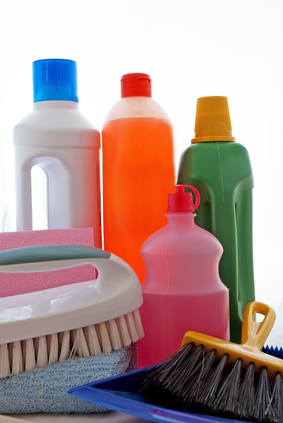Clean With Non-Toxic Products

Aside from how they look, we judge the cleanliness of our homes based on how they smell. Unfortunatley, most of us grew up associating "clean" with the smell of chemicals. The vast majority of cleaning products sold in stores today may degrease and disinfect in pine, lavendar and cotton scents, but these toxic concoctions are all-too-often polluting our homes, our bodies and our planet in the process.
We worry about the pollution outside, but studies have shown the levels of pollutants inside our homes can actually be 100 times greater! Beyond the allergies and illnesses associated with regular chemical exposure, consider what happens to these cleaners that get washed down the drain, be it laundry detergent, dishwashing liquid or drain cleaners. They of course get washed away to the nearest municipal treatment plant, then make their way into our water supplies.
Avoid These Ingredients
APE's (alkylphenol ethoxylates) - A 2002 study of streams nationwide by the U.S. Geological Survey revealed that 69 percent of streams contained detergent metabolites. These "detergent metabolites" were of the class alkylphenol ethoxylates, or APEs, which have been shown to cause male fish to produce female egg-yolk proteins. APE's have also been linked to the proliferation of breast cancer cells in laboratory tests. These detergent metabolites are frequently used in conventional laundry detergents, disinfectants and degreasers.
Phosphates - Though their use is banned in some states, and you will see many products boasting the "no phosphates" label, they are still commonly included in automatic dishwashing detergents. The problem with phosphates is they act as a fertilizer in rivers and streams, and not in a good way. They promote the overproduction of algae, which in turn depletes water of oxygen, making it impossible for fish to thrive or survive.
Petroleum - The thought of "cleansing" our homes in petroleum, and washing it down the drain into our waterways, is no more appealing than watching it gush from broken oil wells into our oceans. Beyond that, use of petroleum-based products only increases our dependence on oil, thus driving the oil exploration that is so damaging our seas and coastlines.
Active Ingredients Chlorine and Ammonia - When these two substances are combined, the chemical reaction is toxic. Since so many cleaning products contain these two ingredients, it is best to avoid their use so as to avoid accidental overlap.
Know Your Labels
- Danger or Poison - extremely hazardous
- Warning - moderately hazardous
- Caution - slightly toxic
- Biodegradable - will break down eventually, as most substances will, but could very well be harmful in the interim
- Natural - could include any naturally-occuring substance, such as petroleum
- Eco-Friendly or Non-Toxic - open to interpretation, as there are no standards regulating the use of these labels
- Organic - may include anything that is carbon-based, such VOCs (volatile organic compounds) that can produce dangerous fumes
Ideal labels to look for include:
- Chlorine Free
- Ammonia Free
- Phosphate Free
- Fragrance Free
- Plant Based
- Biodegradable in 3 to 5 days
Solicit These Companies
Since manufacturers are not required to include ingredient lists on their cleaning products, the vast majority do not. Fortunately, there are a number of eco-conscious companies whose product ingredients you can trust, such as:
- Aubrey Organics
- Bioshield
- Dr. Bronner's
- Ecover
- Naturally Yours
- Seventh Generation
Make Your Own Cleaning Products
There are some cleaning products that are best bought ready-made, such as laundry detergent and dish soap. Again, just be sure you are buying from one of the manufacturers listed above, or another trusted source. However, with the majority of cleaning products, you can easily replace store-bought products with safe, effective solutions you can make yourself with common household ingredients:
- Glass cleaner. In a spray bottle, combine water with 1/4 cup white vinegar and a couple of drops of liquid soap.
- Liquid scrub. Combine baking soda and liquid soap into a creamy, manageable consistency.
- Drain cleaner. Sprinkle 1/4 cup baking soda into drain. Pour in white vinegar until it completely covers the top of the drain and starts to bubble. Keep adding vinegar until it stops bubbling. Follow up with hot boiling water. Keep repeating this process until the drain is clear.
- Stain remover. Combine mixture of water with borax, lemon juice, hydrogen peroxide or white vinegar and let set on stain. Note, only use lemon juice and hydrogen peroxide mixture on whites.
- Fabric softener. Add 1/4 baking soda or white vinegar to wash cycle.
- Oven cleaner. Create a paste of water and baking soda. Leave to set in oven overnight. Wipe clean, using a few drops of liquid soap if necessary to remove all residue.
Though in some instances you may need to use a little (or a lot) more elbow grease than usual when cleaning with natural solutions, it is well worth the time and effort knowing your home is free of toxic chemicals and truly clean!
